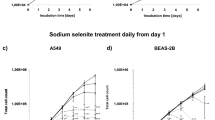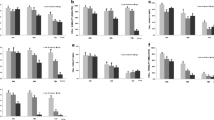Abstract
Docetaxel (DOCX) kills tumor cells through the formation of microtubules, calcium ion influx, apoptosis, and inflammation. However, DOCX has adverse effect on normal tissues through the production of reactive oxygen species (ROS), despite the adverse effect was inhibited by antioxidants. We investigated the protective role of selenium against DOCX-induced apoptosis and mitochondrial oxidative injury in laryngotracheal epithelial (LARYN) cells of mice. Thirty-two mice were divided into four groups (n = 8). The first group was used as a control. The second and third groups were treated with sodium selenite (Na-Sel) and DOCX, respectively. The fourth group was the combined group of Na-Sel and DOCX. At the end of the experiment, LARYN mucosa and cells were obtained from the mice. In the LARYN cells, the cell viability level was low in DOCX group, although glutathione peroxidase activity and cell viability level were increased by the treatment of Na-Sel. Increased lipid peroxidation, intracellular ROS, mitochondrial membrane depolarization, cell death levels, TNF-α, IL-1β, IL-6, caspase -3, and -9 activities in the DOCX group of LARYN cells were diminished by the treatment of Na-Sel. In conclusion, DOCX increased mitochondrial ROS, cell death, and inflammation in the LARYN cells, although the increase was reduced in the cells by Na-Sel treatment. DOCX-induced adverse oxidant, inflammatory, and apoptotic effects in the tissue might be reduced by the Na-Sel treatment.











Similar content being viewed by others
References
Jacob S, Zhu Y, Kraft R et al (2015) Physiologic and molecular changes in the tracheal epithelium of rats following burn injury. Int J Burns Trauma 5(1):36–45
Nazıroğlu M (2007) New molecular mechanisms on the activation of TRPM2 channels by oxidative stress and ADP-ribose. Neurochem Res 32:1990–2001
Berr C, Arnaud J, Akbaraly TN (2012) Selenium and cognitive impairment: a brief-review based on results from the EVA study. Biofactors. 38:139–144
Doelman CJ, Leurs R, Oosterom WC, Bast A (1990) Mineral dust exposure and free radical-mediated lung damage. Exp Lung Res 16(1):41–55
Nazıroglu M (2009) Role of selenium on calcium signaling and oxidative stress-induced molecular pathways in epilepsy. Neurochem Res 34(12):2181–2191
Avery JC, Hoffmann PR (2018) Selenium, selenoproteins, and immunity. Nutrients 10(9):E1203
Zhu S, Gray TE, Nettesheim P (1992) The effect of sodium selenite on cell proliferation and transformation of primary rat tracheal epithelial cells. Carcinogenesis 13(10):1725–1729
Lubiński J, Marciniak W, Muszynska M et al (2018) Serum selenium levels and the risk of progression of laryngeal cancer. PLoS One 13(1):e0184873
Gupta S, Jaworska-Bieniek K, Lubinski J, Jakubowska A (2013) Can selenium be a modifier of cancer risk in CHEK2 mutation carriers? Mutagenesis 28(6):625–629
Borawska MH, Socha K, Łazarczyk B, Czyzewska E, Markiewicz R, Darewicz B (2009) The effects of diet on selenium concentration in serum in patients with cancer. Nutr Cancer 61(5):629–633
Karabajakian A, Toussaint P, Neidhardt EM, Paulus V, Saintigny P, Fayette J (2017) Chemotherapy for localized head and neck squamous cell cancers. Anti-Cancer Drugs 28(4):362–368
Han TD, Shang DH, Tian Y (2016) Docetaxel enhances apoptosis and G2/M cell cycle arrest by suppressing mitogen-activated protein kinase signaling in human renal clear cell carcinoma. Genet Mol Res 15(1):gmr7321
Tabaczar S, Pieniążek A, Czepas J, Piasecka-Zelga J, Gwoździński K, Koceva-Chyła A (2013) Quercetin attenuates oxidative stress in the blood plasma of rats bearing DMBA-induced mammary cancer and treated with a combination of doxorubicin and docetaxel. Gen Physiol Biophys 32(4):535–543
Sarıözkan S, Türk G, Eken A, Bayram LÇ, Baldemir A, Doğan G (2017) Gilaburu (Viburnum opulus L.) fruit extract alleviates testis and sperm damages induced by taxane-based chemotherapeutics. Biomed Pharmacother 95:1284–1294
Altintas R, Ciftci O, Aydin M, Akpolat N, Oguz F, Beytur A (2015) Quercetin prevents docetaxel-induced testicular damage in rats. Andrologia. 47(3):248–256
Baş E, Nazıroğlu M (2019) Selenium attenuates docetaxel-induced apoptosis and mitochondrial oxidative stress in kidney cells. Anti-Cancer Drugs 30:339–346
Song N, Jia XS, Jia LL, Ma XB, Li F, Wang EH, Li X (2010) Expression and role of Oct3/4, Nanog and Sox2 in regeneration of rat tracheal epithelium. Cell Prolif 43(1):49–55
Låg M, Helgeland K, Olsen I, Jonsen J (1986) Effects of cadmium acetate and sodium selenite on mucociliary functions and adenosine triphosphate content in mouse trachea organ cultures. Toxicology. 39(3):323–332
Ataizi ZS, Ertilav K, Nazıroğlu M (2019) Mitochondrial oxidative stress-induced brain and hippocampus apoptosis decrease through modulation of caspase activity, Ca(2+) influx and inflammatory cytokine molecular pathways in the docetaxel-treated mice by melatonin and selenium treatments. Metab Brain Dis 34(4):1077–1089
Gültekin F, Nazıroğlu M, Savaş HB, Çiğ B (2018) Calorie restriction protects against apoptosis, mitochondrial oxidative stress and increased calcium signaling through inhibition of TRPV1 channel in the hippocampus and dorsal root ganglion of rats. Metab Brain Dis 33(5):1761–1774
Zhou Y, Song N, Li X et al (2017) Changes in the methylation status of the Oct3/4, Nanog, and Sox2 promoters in stem cells during regeneration of rat tracheal epithelium after injury. Oncotarget 8(2):2984–2994
Yüksel E, Nazıroğlu M, Şahin M, Çiğ B (2017) Involvement of TRPM2 and TRPV1 channels on hyperalgesia, apoptosis and oxidative stress in rat fibromyalgia model: protective role of selenium. Sci Rep 7(1):17543
Kahya MC, Nazıroğlu M, Övey İS (2017) Modulation of diabetes-induced oxidative stress, apoptosis, and Ca(2+) entry through TRPM2 and TRPV1 channels in dorsal root ganglion and hippocampus of diabetic rats by melatonin and selenium. Mol Neurobiol 54(3):2345–2360
Botsoglou NA, Fletouris DJ, Papageorgiou GE, Vassilopoulos VN, Mantis AJ, Trakatellis A (1994) Rapid, sensitive, and specific thiobarbituric acid method for measuring lipid peroxidation in animal tissue, food, and feedstuff samples. J Agric Food Chem 42:1931–1937
Saxena M, Singhal SS, Awasthi YC (1992) A specific, sensitive, and rapid method for the determination of glutathione and its application in ocular tissues. Exp Eye Res 55(3):461–468
Lawrence RA, Burk RF (1976) Glutathione peroxidase activity in selenium-deficient rat liver. Biochem Biophys Res Commun 71:952–958
Mosmann T (1983) Rapid colorimetric assay for cellular growth and survival, application to proliferation and cytotoxicity assays. J Immunol Methods 65:55–63
Gilbert K, Godbout R, Rousseau G (2016) Caspase-3 activity in the rat amygdala measured by spectrofluorometry after myocardial infarction. J Vis Exp 107:e53207
Wang X, Roper MG (2014) Measurement of DCF fluorescence as a measure of reactive oxygen species in murine islets of Langerhans. Anal Methods 6(9):3019–3024
Uğuz AC, Nazıroğlu M, Espino J et al (2009) Selenium modulates oxidative stress induced cell apoptosis in human myeloid HL-60 cells via regulation of caspase-3, -9 and calcium influx. J Membr Biol 232:15–23
Joshi DC, Bakowska JC (2011) Determination of mitochondrial membrane potential and reactive oxygen species in live rat cortical neurons. J Vis Exp 51:2704
Sakallı Çetin E, Nazıroğlu M, Çiğ B, Övey İS, Aslan KP (2017) Selenium potentiates the anticancer effect of cisplatin against oxidative stress and calcium ion signaling-induced intracellular toxicity in MCF-7 breast cancer cells: involvement of the TRPV1 channel. J Recept Signal Transduct Res 37:84–93
Zhou J, Chen X, Gilvary DL et al (2015) HMGB1 induction of clusterin creates a chemoresistant niche in human prostate tumor cells. Sci Rep 5:15085
Chi Q, Luan Y, Zhang Y, Hu X, Li S (2019) The regulatory effects of miR-138-5p on selenium deficiency-induced chondrocyte apoptosis are mediated by targeting SelM. Metallomics. 11(4):845–857
Yang J, Zhang Y, Hamid S et al (2017) Interplay between autophagy and apoptosis in selenium deficient cardiomyocytes in chicken. J Inorg Biochem 170:17–25
Freitas M, Alves V, Sarmento-Ribeiro AB, Mota-Pinto A (2011) Combined effect of sodium selenite and docetaxel on PC3 metastatic prostate cancer cell line. Biochem Biophys Res Commun 408(4):713–719
Salem EA, Salem NA, Maarouf AM, Serefoglu EC, Hellstrom WJ (2012) Selenium and lycopene attenuate cisplatin-induced testicular toxicity associated with oxidative stress in Wistar rats. Urology 79(5):1184.e1–1184.e6
Aksoy A, Karaoglu A, Akpolat N, Naziroglu M, Ozturk T, Karagoz ZK (2015) Protective role of selenium and high dose vitamin E against cisplatin-induced nephrotoxicty in rats. Asian Pac J Cancer Prev 16(16):6877–6882
Song M, Kumaran MN, Gounder M et al (2018) Phase I trial of selenium plus chemotherapy in gynecologic cancers. Gynecol Oncol 150(3):478–486
Lee JM, Chun HJ, Choi HS et al (2017) Selenium administration attenuates 5-flurouracil-induced intestinal mucositis. Nutr Cancer 69(4):616–622
Mao G, Li Q, Deng C et al (2018) The synergism and attenuation effect of selenium (Se)-enriched Grifola frondosa (Se)-polysaccharide on 5-fluorouracil (5-Fu) in Heps-bearing mice. Int J Biol Macromol 107(Pt B):2211–2216
Guven M, Turan F, Eyibilen A, Akbaş A, Erkorkmaz Ü (2012) A comparison of the efficacy of 5-fluorouracil/triamcinolone, carnitine and dexamethasone therapy on wound healing in tracheal injury: potential for preventing tracheal stenosis? Eur Arch Otorhinolaryngol 269(1):201–216
Funding
The study was supported by BSN Health, Analyses, Innovation, Consultancy, Organization, Agriculture and Industry LTD, Göller Bölgesi Teknokenti, Isparta, Turkey (Project No: 2018-08). There is no financial disclosure for the current study.
Author information
Authors and Affiliations
Contributions
SGK formulated the present hypothesis. MN was responsible for writing the report and analyzing the spectrophotometer, patch-clamp and plate reader. SGK made also critical revision for the manuscript.
Corresponding author
Ethics declarations
Conflict of Interest
The authors declare that they have no conflict of interest.
Ethical Approval
This article does not contain any studies with human participants performed by any of the authors. This study was approved by the Local Ethical Committee of Burdur Mehmet Akif University (BMAU), Burdur, Turkey (Protocol Number: 60-483: Approve Date: 16.01.2019). The mice were cared in accordance with the guidelines of the Animal Care Committee of BMAU.
Additional information
Publisher’s Note
Springer Nature remains neutral with regard to jurisdictional claims in published maps and institutional affiliations.
Rights and permissions
About this article
Cite this article
Kütük, S.G., Nazıroğlu, M. Selenium Diminishes Docetaxel-Induced Cell Death, Oxidative Stress, and Inflammation in the Laryngotracheal Epithelium of the Mouse. Biol Trace Elem Res 196, 184–194 (2020). https://doi.org/10.1007/s12011-019-01914-0
Received:
Accepted:
Published:
Issue Date:
DOI: https://doi.org/10.1007/s12011-019-01914-0




